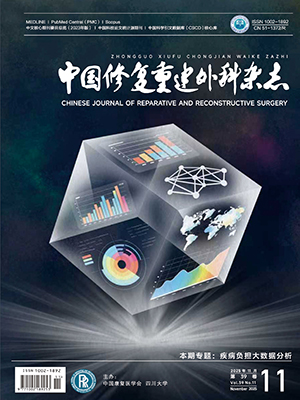Objective To introduce operation skill of the spinal wedge osteotomy by posterior approach for correction of severe rigid scol iosis and to discuss the selection of the indications and the range of fusion and fixation. Methods Between July 1999 and January 2009, 23 patients with severe rigid scol iosis were treated with spinal wedge osteotomy by posterior approach, including 16 congenital scol iosis, 5 idiopathic scol iosis, and 2 neurofibromatosis scol iosis. There were 11 males and 12 females with a median age of 15 years (range, 8-29 years). Two patients had previous surgery history. The Cobb’s angles of scol iosis and kyphosis before operation were (85.39 ± 13.51)° and (56.78 ± 17.69)°, respectively. The mean spinal flexibil ity was 14.4% (range, 4.7%-22.5%). The trunk shift was (15.61 ± 4.89) mm. The preoperative CT or MRI showed bony septum in the canal in 2 patients. Results The mean operative time was 241 minutes and the mean blood loss was 1 452 mL. The average fused vertebrae were 10.7 segaments (range, 8-14 segaments). The follow-up ranged from 1 to 4 years with an average of 2 years and 6 months. The postoperative Cobb’s angle of scol iosis was (38.70 ± 6.51)°, the average correction rate was 54.7%. The postoperative Cobb’s angle of kyphosis was (27.78 ± 6.01)°, the average correction rate was 51.0%. The trunk shift was improved to (4.69 ± 1.87) mm, the increased height was 5.2 cm on average (range, 2.8-7.7 cm). The Cobb’s angle of scol iosis was (41.57 ± 6.80)° with an average 2.9° loss of correction at the final follow-up; the Cobb’s angle of kyphosis was (30.39 ± 5.94)° with an average 2.6° loss of correction at the final follow-up; the trunk shift was (4.78 ± 2.00) mm at the final follow-up. There were significant differences (P lt; 0.05) in the Cobb’s angles of scol iosis and kyphosis and the trunk shift between preoperation and postoperation, between preoperation and last follow-up. Four cases had pedicle fracture, 1 had L1 nerve root injury, 2 had superior mesenteric artery syndrome, 1 had exudates of incision, and 2 had temporary dysfunction of both lower extremity. Conclusion Spinal wedge osteotomy by posterior approach is a rel iable and safe surgical technique for correcting severe rigid scol iosis. With segmental pedical screw fixation, both the spinal balance and stabil ity can be restored.
Citation: GUO Hailong,ZHENG Xinfeng,SHENG Weibin,ZHAN Yulin,PU Lati,XU Tao.. SPINAL WEDGE OSTEOTOMY BY POSTERIOR APPROACH FOR CORRECTION OF SEVERE RIGID SCOLIOSIS. Chinese Journal of Reparative and Reconstructive Surgery, 2010, 24(7): 885-888. doi: Copy
Copyright © the editorial department of Chinese Journal of Reparative and Reconstructive Surgery of West China Medical Publisher. All rights reserved




